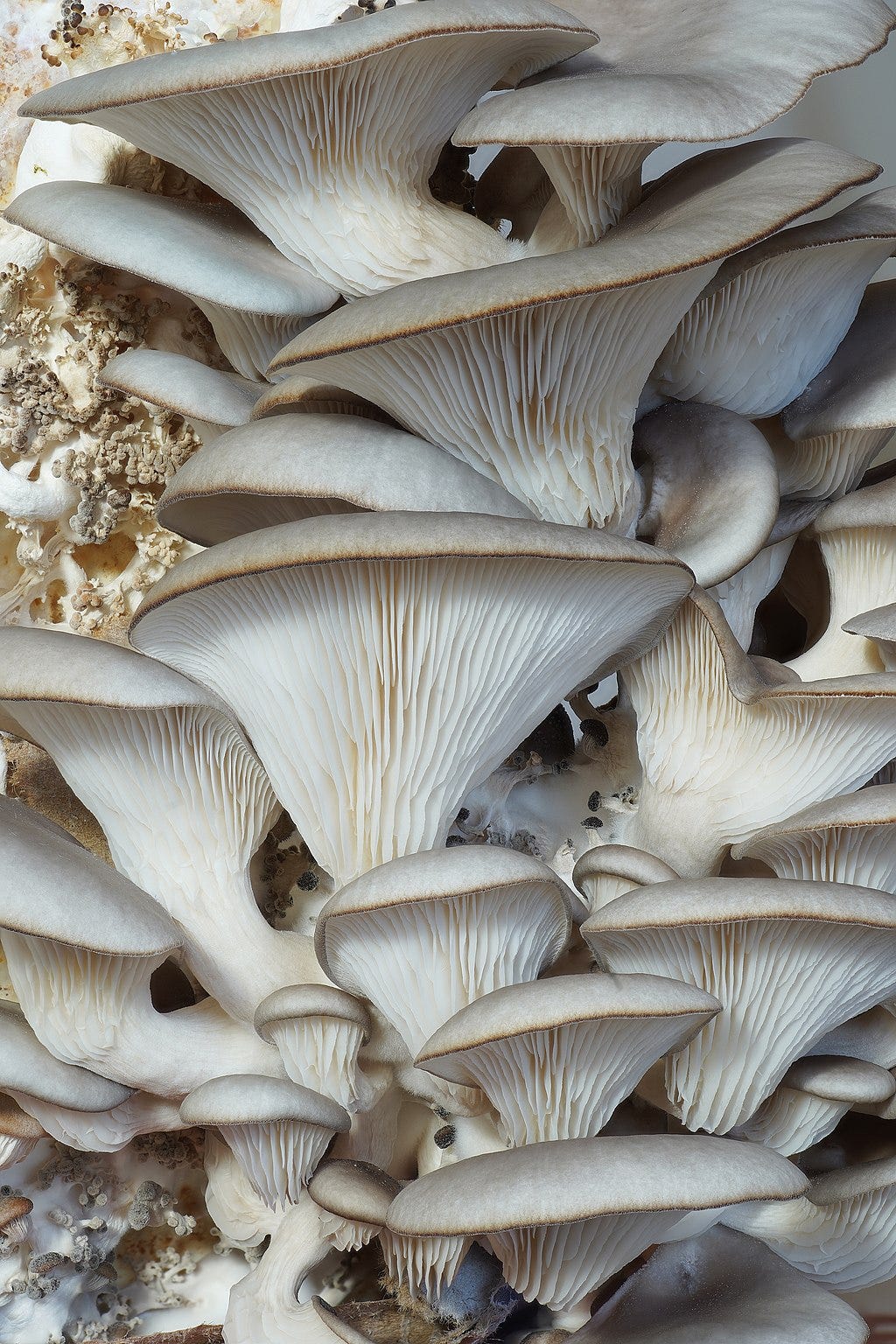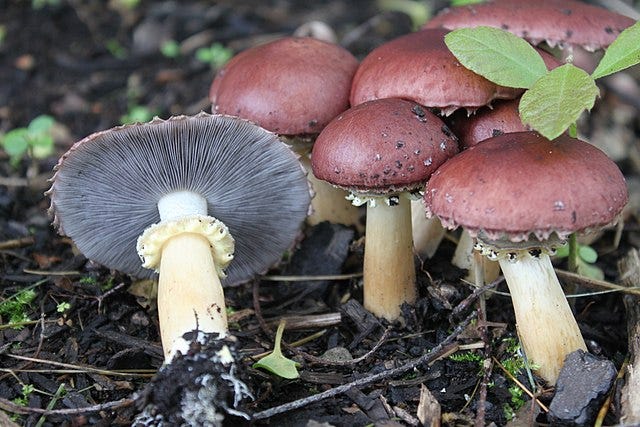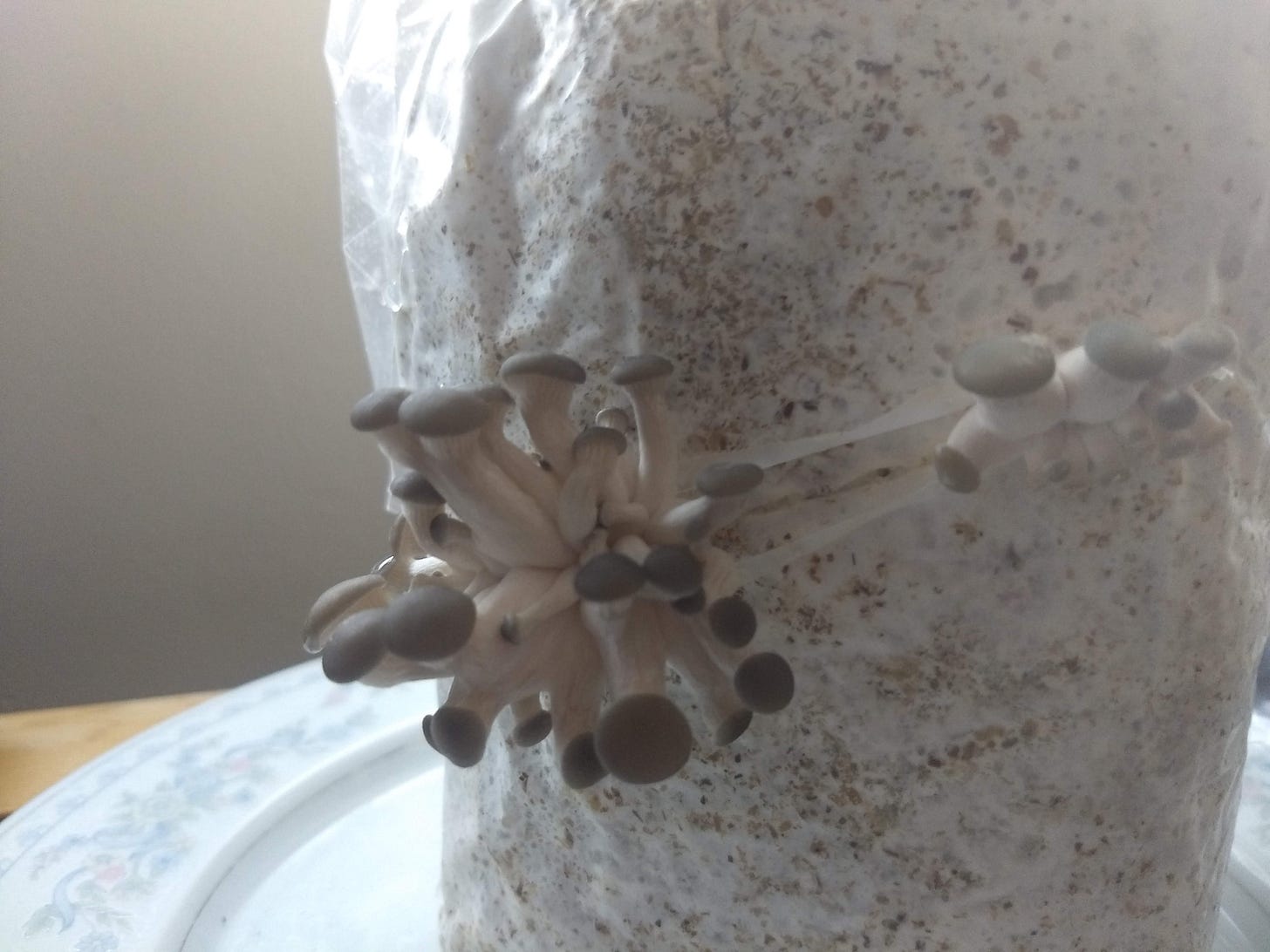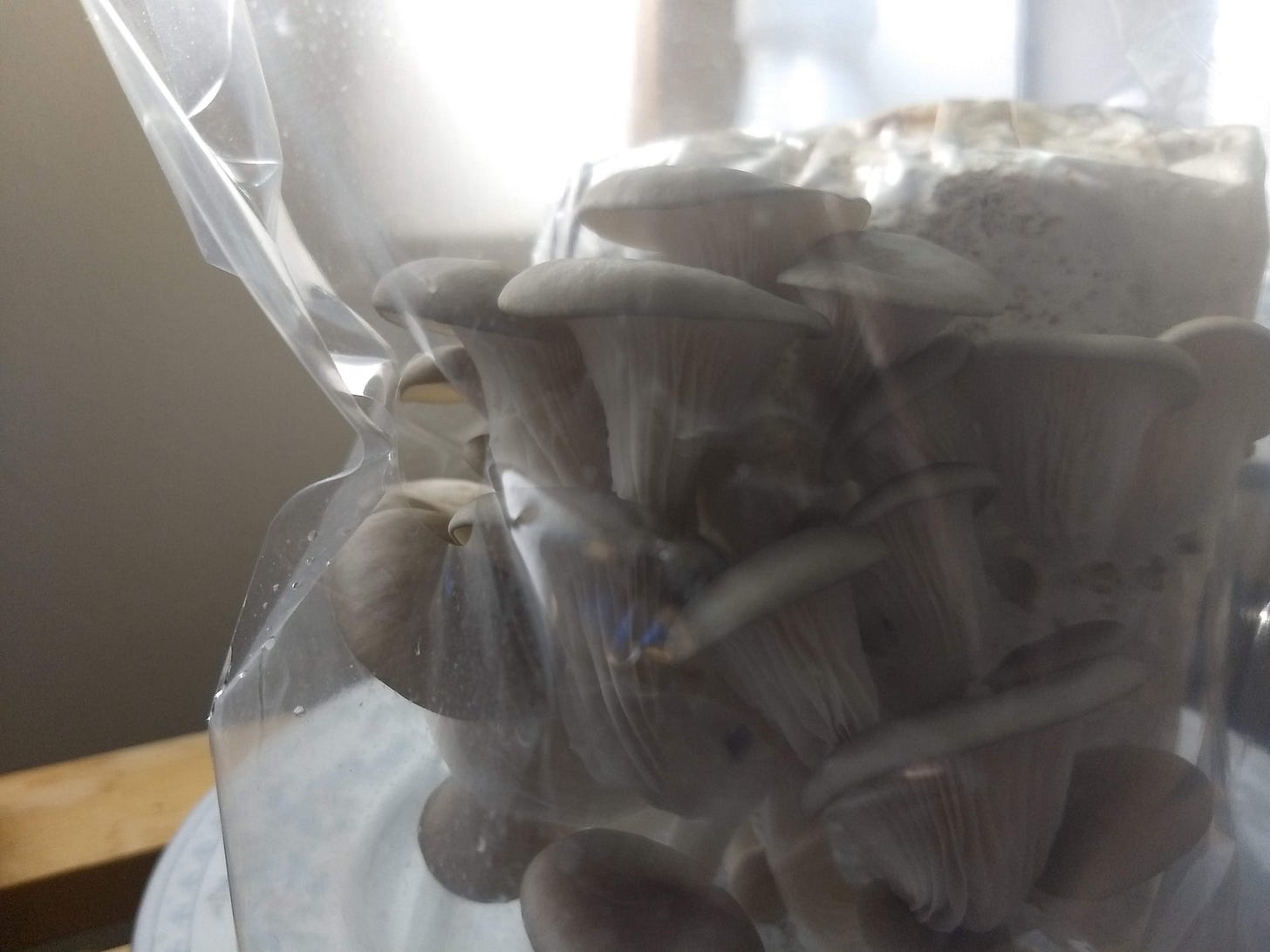It's Actually Easy To Grow Gourmet Mushrooms At Home
From childhood fears to fungal fascination: my journey into mushroom cultivation
Let’s Nerd Out About Gardening is a twice-monthly publication for curious people who love learning about gardening and nature. Sign up here to get new posts straight to your inbox:
Hi Gardenerds,
When I was a child, I hated mushrooms.
It wasn’t because I didn’t like the taste. Like most kids, I decided that I didn’t like it because I didn’t like the look of it. It had gills. Anything could be in there.
It didn’t help that people would tell me that I should eat mushrooms because you are what you eat. They meant something about how mushrooms eat sunshine (they don’t; plants do), but if you are what you eat, then I’d become gills. Ew.
I’ve only recently learned that there’s an actual word for this: trypophobia. Trypophobia is the disgust of repetitive patterns or clustered holes, like those in honeycomb or mushrooms.
As an adult, I still don’t like the gills or the rubbery texture. I know mushrooms are good for me, not because they eat sunshine (which they still don’t), but they’re packed with nutrients, including Vitamin D. They have a distinctive unami taste that I’m not use to, so my husband hides dried shitake mushrooms in sauces. With my permission, of course.
I even once enjoyed oyster mushrooms, when a vegetable delivery bin accidentally gave us some. (I still don’t like button mushrooms.)
Yet, somehow, I’ve managed to fall into the world of mushroom cultivation thanks to YouTube (once again). It showed me a video on how to easily grow oyster mushrooms in a 5 gallon bucket. Great! Growing mushrooms may just be a low cost alternative to buying expensive factory-raised meat, especially if I can just reuse the same oyster grow kit to continually raise more mushrooms.
Let me tell you. If you love to fall down research rabbit holes, then you’ll love mushroom cultivation. I’ve spent weeks in research mode, looking at everything from mushroom kits to hobbyist level cultivation to farm-scale. Even getting a handle on all the terminology takes quite some time.
Luckily, researching and being exposed to so many photos of mushroom gills has helped with my trypophobia, as these other mushroom cultivators have found (there are photos of mushroom gills and pores).
If you too have tryphophobia, there are photos in this newsletter with gills. And pretty much every link.
Something to learn…
Mushroom cultivation is pretty unique in that it’s mainly exploded in the past twenty years, as technology has allowed for people to start experimenting with growing mushrooms at home. For the past century, we used to only get button mushrooms in grocery stores because that’s pretty much all that we could reliably grow on a safe, commercial scale. Now, anyone can grow oyster mushrooms on their kitchen countertop.
And incredibly, most of what’s used today has been developed by people growing mushrooms in their own home. Most gourmet mushroom farms seem to use the same technology, just on a larger scale.
Some basic terms that will help you understand include:
Contamination — the bane of mushroom cultivators. The same conditions that encourage mycelium to grow also grow a bunch of other unwanted things, like mold and rival mycelium. Contamination is when you get something you don’t want growing in your substrate.
Inoculate — to introduce mycelium to a substrate. This could include introducing a liquid culture to grain, or introducing grain spawn to a fruiting block.
Substrate — what the mycelium grows on and eats.
Pasteurized Substrate — bulk substrates like wood chips and straw that are brought up to a temperature that will kill many contamination factors (mold, fungal spores, etc) but not all. They’re easy for newbies to do without specialized equipment (like with the 5 gallon bucket example above), but since these substrates are less nutritious, they produce smaller yields.
Sterilized Substrate — bulk substrates that include highly nutritious food for mushrooms that are brought up to a temperature that kills all contamination factors. Sterilizing substrates means using a pressure cooker since only a pressure cooker can raise the temperature above boiling.
Liquid Culture (LC) — a nutrient-rich solution used to grow mycelium that reduces contamination. You can make your own or buy liquid culture in syringes to inoculate your own grain spawn.
Grain Spawn — nutritious grain used to grow mycelium from the liquid culture stage so that it’s ready to be introduced to a fruiting block.
Fruiting Block — a pasteurized or sterilized substrate that will get the mycelium ready to fruit into mushrooms. This is essentially what a mushroom grow kit is
!!! Always cook mushrooms when eating! Some mushrooms can be eaten raw (like button mushrooms), but many (like morels) are toxic while raw. Better safe than in the ER.
Here’s a couple easy mushrooms to start with:
Oyster (Pleurotus ostreatus)

Difficulty level: Easy
Cultivation Methods: Versatile
Taste: Depends on the variety, with Kings meaty, yellows sweet, and pinks seafood-like. Cook before eating.
Oyster mushrooms are most home growers’ first gourmet mushroom. They’re just so easy and prolific to grow even without ideal treatment. They grow vigorously, outcompeting other possible contaminations in pasteurized substrates, so new growers don’t need to invest in pressure cookers and laminar hoods. You can easily break up an oyster mushroom kit to add to new substrate to keep it going.
Once my grow kit starting pinning, it seemed to change every time I looked at it. Every few hours, it seemed to have already grown. That’s how fast they grow.
But that vigorous growth comes with a downside: high spore load.
When I first researched and bought my first oyster kit, I hadn’t seen any mention about the dangers of spores. I only found out this tidbit after I’d started growing my kit.
Most people immediately think about your house — are oysters going to worm their way through every wood joint? Well, probably not. Oysters only grow in wet, rotting wood, so if they do take hold, they’re only exposing existing problems.
I’m more concerned with the potential harm to human health. Now, one oyster grow kit harvested at the right time isn’t a problem. If you’re growing a few kits at one time or you’re sensitive to fungal spores (or have a body like mine that gets easily overwhelmed — you want me to also deal with what now? *sigh*), then you need to take precautions. These precautions are doable, but also make it harder to get started. You can also grow them outside if the weather cooperates.
Fortunately, someone has bred a sporeless grey oyster that’s actually sporeless, and it grows just as well as regular oyster mushrooms. It’s available in a ready-to-grow kit in some places, but not in Canada (as far as I’ve found — if you know of a source, please let me know!). I found a few places that offer it as a liquid culture, so I’m going to buy some sterilized grain spawn and try it out myself.
Oysters are being explored for mycoremediation, as they’re capable of adapting to and breaking down many toxic chemicals (like motor oil) and even plastic. If you do experiment with mycroremediation, don’t eat the mushrooms as the toxins might end up in the caps.
Wine Cap/King Stropharia (Stropharia rugoso-annulata)

Difficulty level: Easy
Cultivation Methods: Outdoors
Taste: Spring and fall mushroom with a meaty texture and potato flavor. Cook thoroughly and eat in moderation (not more than two days in a row) as too many can cause indigestion.
Wine Caps are the easiest mushroom to cultivate outdoors and a great companion in a vegetable garden. Unlike most other gourmet mushrooms, they can take a bit of direct sun, so long as they have some leaf cover from your other plants.
Having grown up being told never touch or eat wild mushrooms because they’ll probably kill you, growing mushrooms outdoors is something that I’ll need to work up to.
But Wine Caps can be great for your garden, even if you don’t harvest them. They speed up the composting process of wood shavings and straw. While you can create a separate garden bed for them, they also grow as easily in wood shaving covered walkways between garden beds or under berry bushes.
They’re also prolific for the amount of work you need to do setting them up. Unlike oysters, which have to be respawned into new pasteurized substrate after a few fruiting cycles, you just need to keep refreshing the wood shavings or straw. They fruit twice a year in spring and fall, or basically when you get cooler, wetter temperatures.
Something to read…
📔 DIY Mushroom Cultivation: Growing Mushrooms At Home For Food, Medicine, and Soil by Willoughby Arevalo
Blog and forum posts are very helpful, but it’s really useful to see all the steps laid out. I liked this book by Willoughby Arevalo as a really thorough overview, including the mushroom life cycle and many different cultivated mushrooms. The written instructions can be a bit hard to follow, and I found that watching videos for each part made it much more straight forward.
How to Grow Mushrooms — The Seven Basic Steps by FreshCap
A quick overview of the full process of growing mushroom. But you can technically jump in at any step. Grow kits allow beginners to start at step 6: pinning. Buying inoculated grain spawn can allow you to start at step 4: spawning in fruiting container. And liquid culture allows you to start at Step 2: inoculating grain spawn.
Seven Stages of Cultivation by Cornell Small Farms Program
If you want even more details and data than the above article, this article has you covered.
🔬Mushrooms seem to be able to regulate their own temperature by David Nield
One question I have about trying to grow my oysters outside is what happens when it inevitably gets up to 30C (86F)? Turns out that mushrooms can keep themselves 2.9C (5.2F) or even more cooler than their surroundings so long as they have water. (Researchers still don’t know why, though.)
🔬Fungi Physics: How Those Spores Launch Just Right by Kenneth Chang
Mushrooms don’t just drop their spores straight down and hope for an errant wind. Mycologists knew that spores launched themselves, but not until this study did they know how.
🔬Ecologists use mushrooms to detoxify soil and water after wildfires by foodtank
I’ve had trouble finding more rcent information on this, but in 2019 and 2020, local groups have been using mushrooms for toxin remediation after the wildfires in California.
🔬Plastic eating mushrooms: a viable solution to plastic decomposition by Kayla Vasarhelyi
Mushrooms could also be the answer to decomposing plastics in landfills and the ocean. While oysters can break down plastic, Pestalotiopsis fungi can break down polymer polyester polyurethane (PUR) in oxygen-free conditions (like in a landfill or underwater).
🤲What can fungi teach us about healing trauma? by Katarina Sabados
As Sabados grows oyster mushrooms for the first time, she makes connections between how mycelium grow with what we humans need to heal trauma.
🍳 Golden Oysters: A sunny shroom that morphs into different textures by J.B. Douglas
But what do you do with all the mushrooms? J.B. Douglas has a couple posts about different oyster mushrooms and how best to cook them, including this one featuring golden oysters. If you like foraging or expanding your culinary ingredients, join his weekly newsletter.
Something to watch…
🎥 Mushrooms For Years To Come!! by The Wilsons on Wilson
I really like this Youtube channel (their videos are stunning), and I think they should get more attention. They’re fixing up an abandoned farm in BC with a load of friends. Most farming videos just show the farmers, but they have a whole community of help. In this video, they’re inoculating shitake and wine cap mushrooms for outdoor cultivation.
🎥 How much does a low tech mushroom farm cost? by GroCycle
I’m always interested in seeing the costs of different farming/gardening methods, and this video by GroCycle shows the estimated costs of four different scales of mushroom farming, from hobby to large-scale commercial production.
🎥 Do Mushrooms Need Light To Grow? by GroCycle
Another video by GroCycle, showing the effects of light starvation on fruiting mushrooms. This is a thing I initially got wrong when setting up my mushroom kit.
🎥 Dance of the spores by Planet Fungi
Closeup slow-mo video of mushrooms releasing spores.
🎥 This is what a REAL functional mushroom farm looks like by FreshCap Mushrooms
This video shows the very different conditions used to farm medicinal mushrooms reishi (Ganoderma lucidum) and cordyceps (Cordyceps militaris). This is actually part of a regular mushroom news show by FreshCap Mushrooms, and they have a lot of interesting mushroom-related stories.
✍ Share with us in the comments:
Do you cultivate mushrooms? Have you ever thought about it? Do you hate mushroom gills too?
Happy growing!
Tanith
In case you missed it…
P.S. Here’s my own oyster mushroom growing journey. For a week or two, it did nothing. I started misting more. Once it started pinning, it seemed to have grown every time I looked at it!


They became a delicious mushroom risotto, thanks to my husband. I might harvest them earlier, though, as I think some of the mushrooms were tougher/chewier from age. The others were delicious. Smaller harvest, better texture (to me, anyway).





